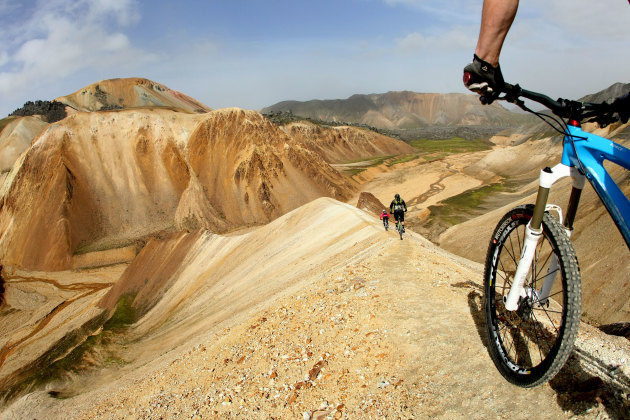Mountain Biking in Iceland
Find yourself a globe of the world, put one finger on Australia, and then go to the absolute opposite site of the planet; chances are you’ve just found Iceland. The name isn’t particularly welcoming and it’s about as far from home as you can get. It’s traditionally quite expensive too, so why on earth would you want to go there for a mountain biking holiday? Hopefully the photo in front of you have already answered that question. Iceland is like nowhere else on earth and despite the distance, logistical difficulties and costs involved, we can guarantee a dirty adventure in Iceland is something you’ll neither regret, nor ever forget.
With a land area a tad smaller than Tasmania and only 60% of the Apple Isle’s population, Iceland has plenty of open space to explore. You’ll find everything from easy dirt road touring to edge of your seat singletrack all surrounded by a landscape that will leave an indelible impression on your psyche.
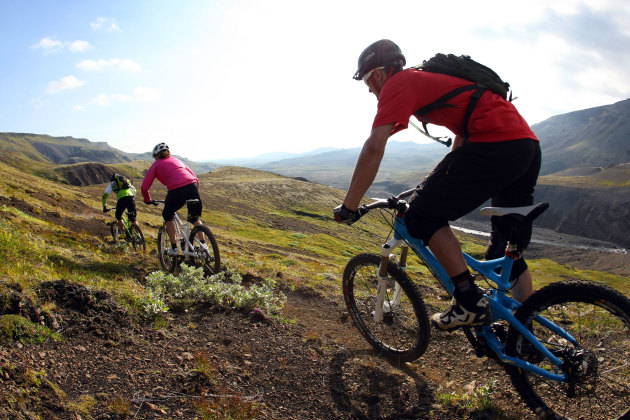
The name itself is actually a bit misleading; although it borders the Arctic Circle, Iceland is warmed by the waters of the Gulf Stream, and as such has a relatively temperate climate for its latitude. In fact it’s believed there was a deliberate mix-up by the early Viking settlers (or, alternatively, too much vodka over the cold, dark winter) to keep possible invaders away; they named Greenland (which is actually covered in ice) to tempt potential marauders, and Iceland, which is generally green, to help keep them away!
Geographically Iceland is quite diverse, with low lying plains around the southwest coast, deep fjords around the north and east of the country and a mountainous, elevated and uninhabited central plateau. Around two-thirds of all Icelanders live in and around the capitol of Reykjavik on the south-west coast and all of the major towns are connected by the ‘Ring Road’, a 1,300km sealed road around the island’s circumference. Nearly 70% of all the other roads in Iceland are unpaved, so there’s certainly no shortage of on-dirt touring potential, and with the coastal plains being relatively flat, travelling by bike is accessible for anyone of moderate fitness.
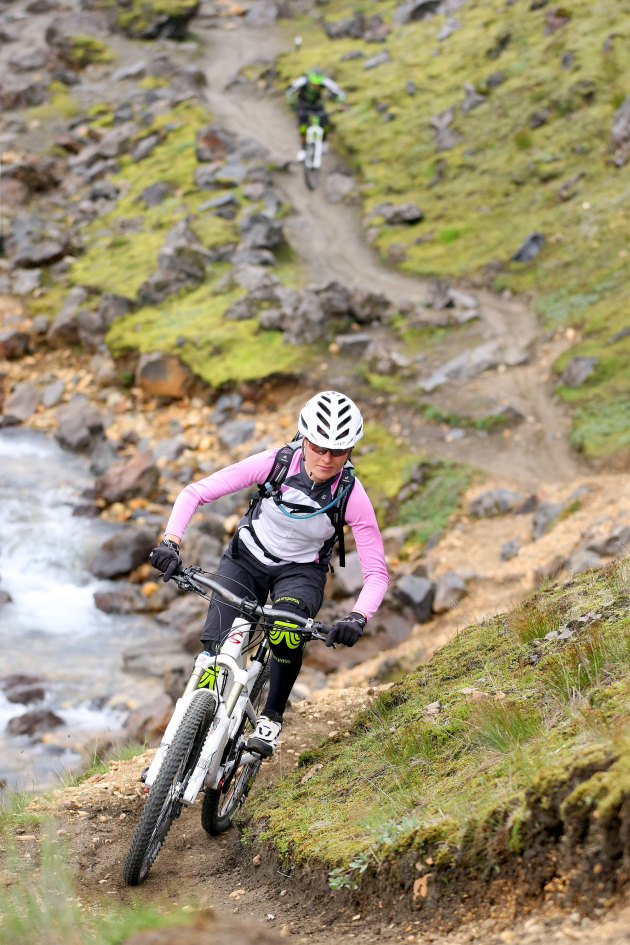
DIPPING YOUR TOES AT THE EDGES
If you want your cycling a bit on the ‘easier’ side there’s plenty of opportunities for sightseeing and touring in the coastal plains around Reykjavik, whether you’re after a daytrip or a few nights out at a time. You could start with an easy pedal through the Heidmörk Nature Reserve about 10km from the centre of Reykjavik, a popular recreation and picnic area with the locals and famous in summer for its vibrant wildflowers and birdlife, as well as its lava flows and caves. An easy day exploring the roughly 30km of gravel paths is a great way to introduce yourself to the natural wonders of Iceland.
A wide variety of tour operators have daytrips out to the Reykjanes Peninsula, a lunar-esque landscape of craters, lava, volcanic sand and hot springs which is well worth a trip, either self-guided or with a group. This area is also home to the famous ‘Blue Lagoon’ geothermal spa, renowned for the reported health-giving properties of its mineral rich waters. The rugged coastline around Grindavik is home to thousands of sea birds, and is pummelled by the wind and water of the North Atlantic; it’ll give you a new appreciation for the bravery of those who first sailed the nearly 1,000km from Denmark and Norway in small open boats!
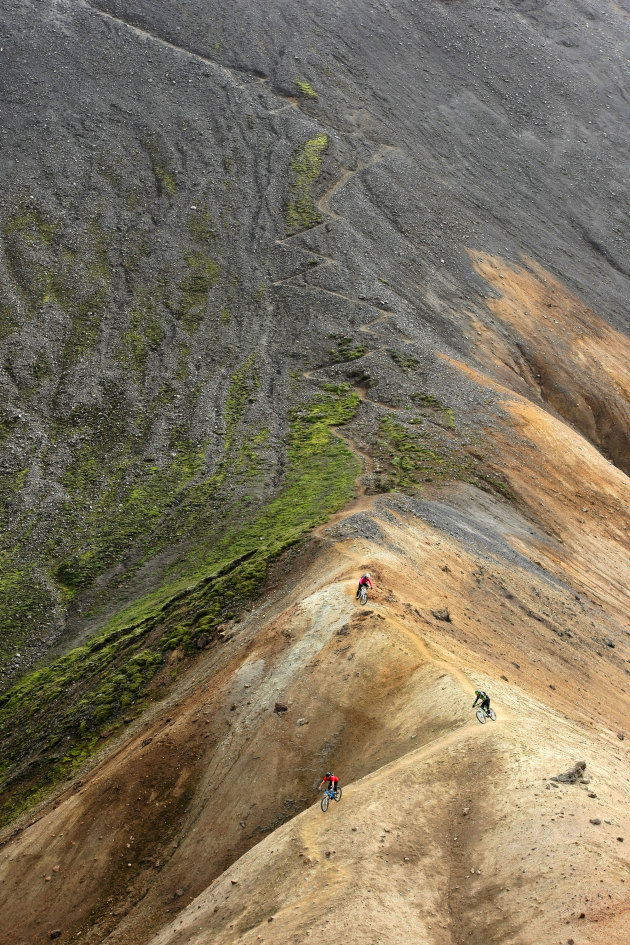
If you’re up for a more serious challenge but still want to be home in time for dinner, your best bet is to organise a trip to either Skaftafell or Reykjadalur (Steam Valley). Whilst it’s further away from the capitol, the riding in Skaftafell is mostly on gravel roads and more open trails, with the main attraction being the gob-smackingly stunning and varied scenery, from birch forests to mountains to deep glacial valleys and rivers and both hot and (very) cold springs; best to tape your mouth closed at the start of the trip so you’re not constantly stopping to pick your jaw up off the ground! At the end of a day’s riding you won’t even notice you’ve got sore legs and have cold wet feet because your head will still be spinning from the visual overload of this astonishing place.
Reykjadalur is a favourite spot with Reykjavik’s MTB community; it’s about 30km from the city centre so access is fairly easy, however the landscape is anything but urban and it’s home to some of the most technically demanding trails in Iceland. The scenery is not quite as varied as Skaftafell but is just as stunning, with amazing contrasts of orange, green and black, punctuated by the white of steam rising from dozens of geothermal vents scattered across the terrain. You can stop along the way to take photos for the benefit of friends back home, but whenever you close your eyes you’ll be able to see yourself and your bike flashing through this remarkable landscape. A bike with 120mm-160mm of travel is the order of the day in Reykjadalur, with plenty of exposed rock, steep descents and narrow trails snaking their way nearly 10km from the top of the valley all the way to its floor; brakes singing with heat, arms pumped, eyes wide and grinning from ear to ear, you’ll be champing at the bit to turn around and do it all over again until your body can’t take any more. Finish off the day with a soak in a hot tub, a drink or two and a hearty meal and you’re ready to do it all over again.
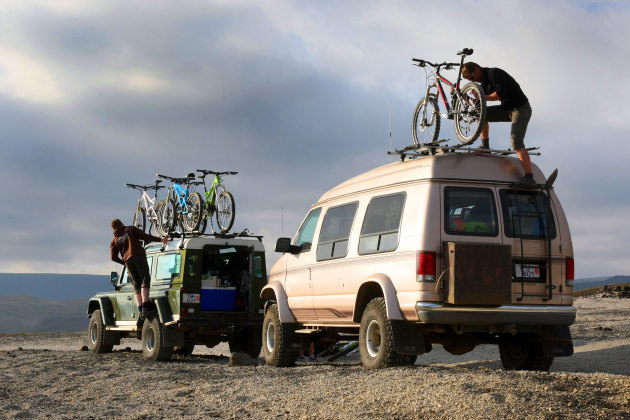
PLUNGING INTO THE CENTRE
Iceland’s interior plateau is a place of harsh beauty and stark contrasts; it’s both Europe’s biggest desert and it’s most active volcanic region, as well as having permanent glaciers covering over 10% of its surface. There are hundreds of small streams and glacial rivers as well as numerous geysers and hot springs; Iceland is one of the most geologically and volcanically active places in the world, with a volcanic eruption roughly every five years—who can forget, for instance, the 2010 eruption of Eyjafjallajökull? It’s hard to imagine any other place where fire and ice, drought and flood, are so bizarrely juxtaposed upon a landscape; and it’s here where the serious mountain biker will find some of the most memorable riding in the world.
Despite its small (by Australian standards) size, the interior of Iceland is remote, has no permanent population, has extremely variable weather and is not the place to go riding if unprepared; in fact if you want to make the most of a trip on the plateau we’d recommend you go on a guided (or at least supported) trip. There are quite a few companies who offer trips of different lengths and styles through the interior plateau (a couple are listed on page 34) so you should be able to find something to suit your plans and budget.

If you want to absorb the scenery of Iceland’s interior without too much of a technical challenge, perhaps the best bet is to plan a trip in the Langjökull region, home to Iceland’s second-largest glacier.
Riding in this area is mostly on gravel roads, and the riding north and east of the glacier takes you through the centre of the highlands; there are quiet mountain lakes and streams scattered throughout the area as well as hot springs and historical settlements. You’d be crazy not to stop by the remarkable Gullfoss waterfall, where the mighty Hvita River appears to vanish into the ground. There’s a good reason this is one of the most popular tourist attractions in Iceland.
The most quintessentially Icelandic (and the most demanding) trip will take you through the Fjallabak and Landmannalaugar region of the highlands. A five or six-day guided tour here can have you riding at your limit day in day out, surrounded by glaciers, lakes, waterfalls, lava flows, volcanic craters, hot springs, black deserts and razor-sharp rainbowcoloured rhyolite peaks. It’s hard to imagine anything more different to trails at home and that alone makes it worthwhile; the fact that this is world-class riding in almost perpetual daylight is simply the icing on the cake.
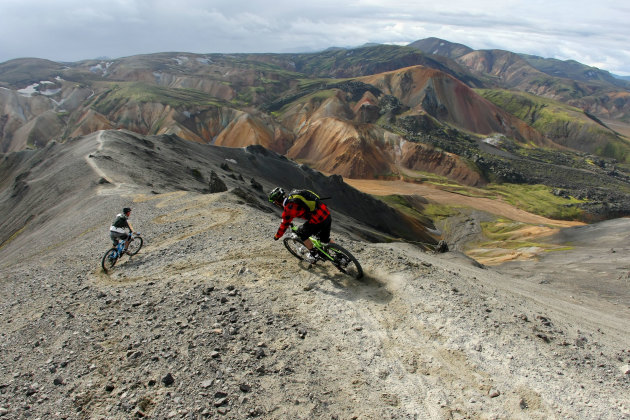
So next time you’re planning an overseas MTB trip, don’t just think of Canada, or the US, or even France; sure these countries have a multitude of great riding, but for a truly memorable cycling adventure, put Iceland at the top of your list. Its mix of culture, climate, amazing trails and truly unique geology are guaranteed to make for an experience that’ll stick with you for life; after all, the sun never sets on the trails in Iceland!
GENERAL INFORMATION
GETTING THERE
Keflavik International is the largest airport in Iceland, 50km outside Reykjavik; it’s serviced primarily by Iceland Express and Iceland Air, although there are probably a dozen or so other airlines from the US and Europe who also fly into and out of Iceland including EasyJet, Delta Air Lines, Transavia France and Lufthansa. Almost all domestic flights are operated through Reykjavik’s domestic airport in the centre of the capitol. If transferring, you’ll need to allow at least three hours between flights.
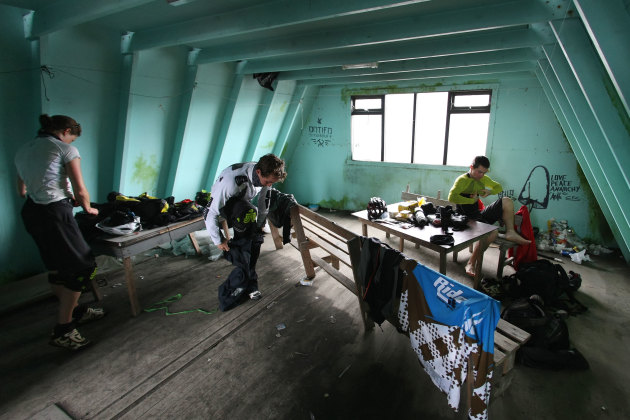
There are no railways in Iceland and although there are coach services between major towns, many Icelanders choose to fly instead. There is an okay bus service in Reykjavik (as well as in the northern town of Akureyri). If you want to travel around Iceland independently you’ll need to hire a car; major companies will charge around $750-$1,000 a week in peak season, so we’d suggest you ride or use shuttles provided by tour operators as much as possible!
WHEN TO VISIT
Summers are short in Iceland, with the best time to visit being late May to early September. At this time of year you can expect average daytime temperatures of 10-13-degrees near the coast, and a little less in the highlands; although weather in Iceland is highly variable and you should be prepared for snow and strong winds even in the height of summer.
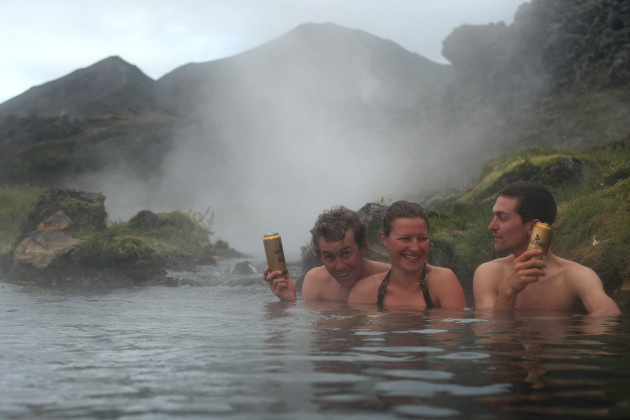
Whilst the weather may be on its best behaviour in mid-summer, it’s also the time when you’ll find the heaviest traffic on famous treks like the ‘Laugavegur’. Riding in the national parks is mostly forbidden, so once again it’s best to consult with a local guide for guidance. On a more positive note there’s the almost continuous daylight from the end of June to mid-July, so you don’t have to waste a single minute of your precious holiday time due to darkness!
As is common in many northern European countries, summer is a time for celebration, so there’s a very good chance there’ll be some sort of music, art, food, or cultural festival going on during your stay. Possible options include the ‘Great Fish Day’ festival in Dalvik where attendees are treated to a free, all-you-can-eat seafood smorgasbord, the six-day Viking Festival in Hafnarfjordar, or the Midnight Sun Run or Festival of the Sea in Reykjavik. Be sure you take in at least one of these festivals as Icelanders have a unique culture, are very welcoming, friendly people and love any excuse to celebrate.
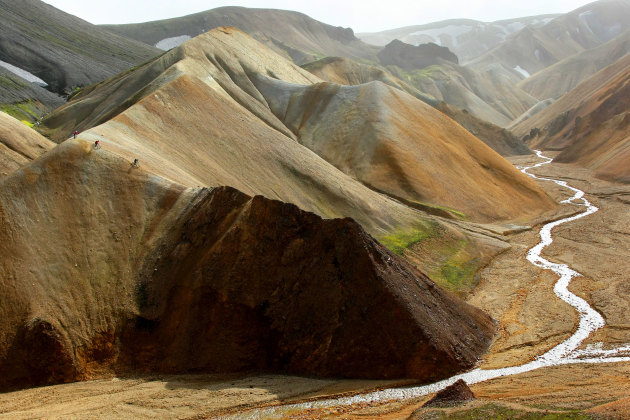
TRAVEL ESSENTIALS
Australian citizens do not require a tourist visa to enter Iceland as long as your total stay in the Schengen area (which covers most countries of Northern and Central Europe) is not longer than 90 days per 180 days. You will, however, need to ensure your passport has blank visa pages and is current beyond your stay.
Most (especially younger) Icelanders will speak English fluently; you won’t need to learn any Icelandic to get around, although learning a few basic words will certainly be appreciated, even if you can’t quite get the pronunciation right. Icelandic is the ‘purest’ of the Nordic languages with very few words absorbed from other sources; if you want to know how the Vikings spoke you’re in the right place!
Iceland’s official currency is the Króna (ISK); at the time of writing AUD$1 was approximately 130 ISK. As always, check exchange rates at the time of travel as fluctuations can occur.

Hotels in major cities are similar prices to Australian capitals and will fill up quickly in high season. You can rent private apartments in many areas which may accommodate small-medium sized groups, and offer better value and a more ‘authentic’ Icelandic experience. Especially outside the major centres there are plenty of B&B and farm-stay options, which will give you a much closer contact with the local culture and landscape than a hotel could offer. It’s also possible to camp cheaply in dozens of places around the country (including Reykjavik) if you’d like to be fully independent and don’t mind carrying extra gear.
Being an island with limited farming potential, Iceland’s cuisine is fairly fish-based and fishing accounts for around 40% of Iceland’s exports. Uniquely Icelandic foods include the ‘delicacy’ hákarl, a fermented shark meat which makes most foreigners spot-vomit, and also singed sheep heads (yep, you read that correctly); there’s no shortage of ‘normal’ food available, but there’s also plenty of opportunity to push your culinary boundaries. You might also want to try the traditional Icelandic liquor Brennivín (‘burning wine’), a type of Schnapps made from potatoes and flavoured with caraway seeds; much more palatable than some of the traditional foods! Eating out can be very expensive, so wherever possible try to buy groceries and cook your own food.
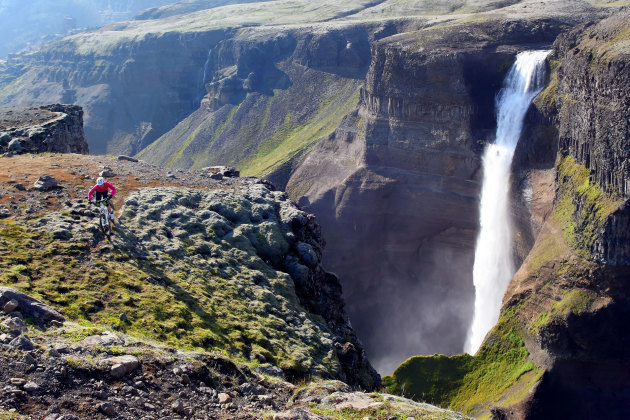
GUIDES & BIKE HIRE
Most MTB guiding services will have a range of hardtail bikes available for hire; these will be fine if you’re planning on sticking to basic touring and lighter trail riding, but for the more serious adventures in the central plateau you’re best to take your own dual suspension bike. You can check the Icelandic Mountain Bike Club’s website for a list of bike shops for essential spares, but make sure your bike is in good working order before you travel and carry emergency parts with you if travelling independently as there aren’t a lot of bike stores outside the greater Reykjavik area.
When you’re not riding or checking out a festival, you might like to get out and enjoy a spot of whale watching or horse riding to break things up, or just hang out in one of the natural hot spring pools that abound throughout Iceland. There’s plenty of trekking opportunities as well, however if you can walk there, you can probably ride too and we know which is more fun, especially on the way down!
USEFUL LINKS
Icelandic Mountain Bike Club –
www.fjallahjolaklubburinn.is/content/view/112/104/
Opus Adventures –
www.opusadventures.is/index.html
Icelandic Mountain Guides –
www.mountainguides.is
Red Apple Apartments (accommodation) – www.redappleapartments.com
